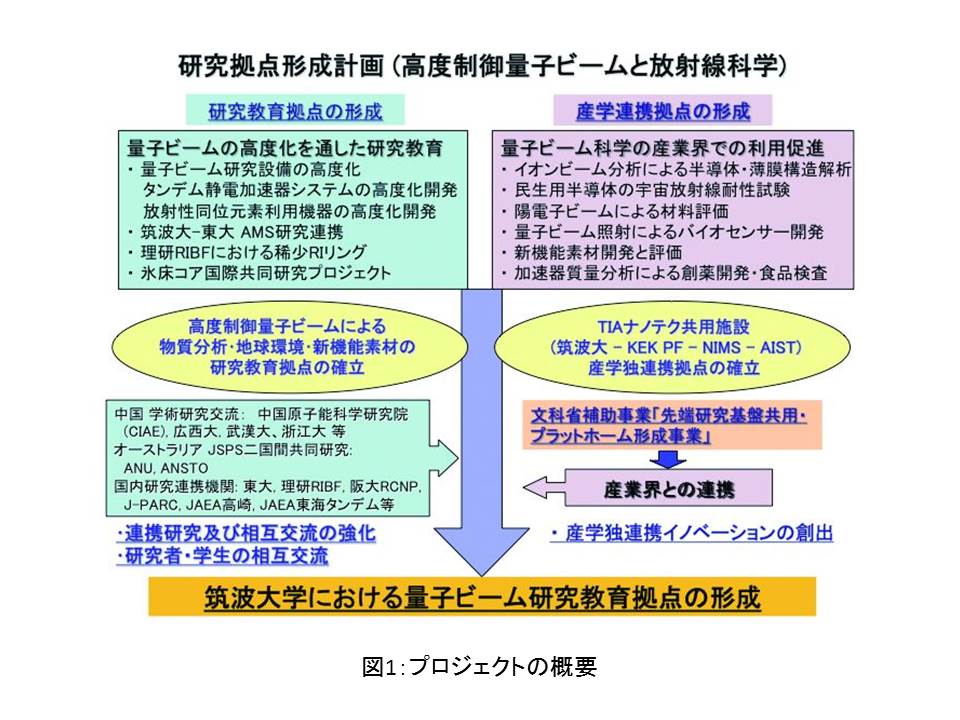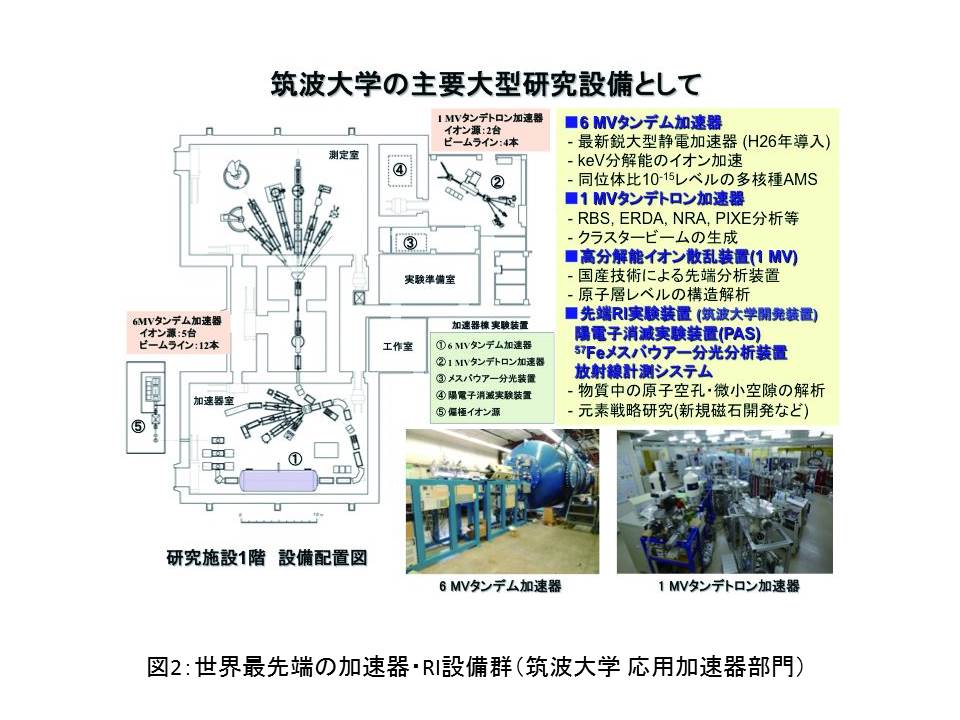キーワード:量子ビーム、放射線科学、物質構造解析、極微量核種分析、産学連携研究
 筑波大学には加速器や放射性同位元素利用機器が数多くあるのをご存知でしょうか。筑波大学応用加速器部門には、世界最新鋭の大型タンデム加速器など3台の静電加速器と陽電子消滅実験装置などが装備されています。私たちのリサーチユニットでは、加速器や放射性同位元素から人工的に得られた放射線(量子ビーム)を高度に制御して、物質のナノ加工や構造解析、地球・環境動態研究から年代測定、放射性核種分析による原子力災害調査までの幅広い研究分野を探究しています。高度制御量子ビーム研究を世界規模で展開し、研究教育と産学連携の拠点形成を視野に入れた社会に役立つ新たな学際領域を開拓しています(図1)。
筑波大学には加速器や放射性同位元素利用機器が数多くあるのをご存知でしょうか。筑波大学応用加速器部門には、世界最新鋭の大型タンデム加速器など3台の静電加速器と陽電子消滅実験装置などが装備されています。私たちのリサーチユニットでは、加速器や放射性同位元素から人工的に得られた放射線(量子ビーム)を高度に制御して、物質のナノ加工や構造解析、地球・環境動態研究から年代測定、放射性核種分析による原子力災害調査までの幅広い研究分野を探究しています。高度制御量子ビーム研究を世界規模で展開し、研究教育と産学連携の拠点形成を視野に入れた社会に役立つ新たな学際領域を開拓しています(図1)。

世界最先端の量子ビーム研究拠点の形成を目指して
加速器や放射性同位元素利用機器はその取り扱いが難しく、学術・産業界での利用普及が進展しているとは言い難い状況です。筑波大学では30年以上にわたる量子ビームの基礎研究と応用技術開発の実績があります。図2に、本リサーチユニットが筑波大学応用加速器部門において研究開発を進めている高度制御量子ビーム研究装置を紹介します。これらの研究装置は、他の大学・研究機関には無い世界最先端の研究設備群です。また現在、正しい放射線知識に関する教育が重要な課題となっています。先端的な研究ばかりでなく、高校生の体験学習などを私たちは積極的に受け入れています。
量子ビーム利用による学際研究と産学連携研究の展開
2014年に筑波大学に導入される世界最新鋭の6 MVタンデム加速器システムは、先端材料物質分析、ナノ精度加工、地球環境科学、原子核・原子物理学から文化財・考古学などの年代測定研究、医薬分野への応用など、大学での先端的な研究教育活動に利用可能です。今後これらの先端的な高度制御量子ビーム研究装置を駆使して、産業界への技術供与と製品開発への協力を進め、加速器・放射線を利用した豊かな未来社会の形成に向けて、量子ビーム産業利用技術のシーズの開拓に努めていきます。

社会への貢献・実績
● 文部科学省「先端研究基盤共用・プラットフォーム形成事業」に採択されており、産業界・学術界への高度制御量子ビーム研究装置の利用開放を行っている。これまでに30件を超える産学連携研究を実施
● TIAナノテク共用施設に参加し、筑波大学における先端研究施設のオープンファシリティ構想を先導
● つくば地区の研究機関と連携して、「つくば先端機器共用施設連携ワークショップ」を開催
● 国内の静電加速器施設・研究グループの基幹施設としての役割を果たしている
(取材:平成25年11月29日)
Toward the Formation of a Productive Future Society Utilizing Accelerators and Radiation
Unit members : Sekiba, Daiichiro Kurosawa, Masanori Ozawa, Akira 長江 大輔 Tomita, Shigeo Sueki, Keisuke
Unit name: Research Unit for Advanced Control Quantum Beam
Key words: Quantum beam, radiation science, material structure analysis, ultratrace nuclide analysis, industry-university collaborative research
Do you know that the University of Tsukuba has large numbers of accelerators and equipment using radioactive isotopes? The University of Tsukuba Tandem Accelerator Complex (UTTAC) has three  electrostatic accelerators, including the world’s most advanced large tandem accelerator, the positron annihilation spectroscopy device, and other equipment. Our research involves the advanced control of radiation (quantum beams) generated by accelerators or obtained from radioactive isotopes artificially. The research unit conducts research in a wide range of scientific fields: nanoengineering of materials and analyses of their structures, research on the dynamics of the earth and environments, radioactive age dating, and surveys of nuclear disasters by radioactive nuclide analysis.
electrostatic accelerators, including the world’s most advanced large tandem accelerator, the positron annihilation spectroscopy device, and other equipment. Our research involves the advanced control of radiation (quantum beams) generated by accelerators or obtained from radioactive isotopes artificially. The research unit conducts research in a wide range of scientific fields: nanoengineering of materials and analyses of their structures, research on the dynamics of the earth and environments, radioactive age dating, and surveys of nuclear disasters by radioactive nuclide analysis.
The research unit conducts research on the advanced control of quantum beams at a global level, and promotes the development of a foundation for research-based education and university-industry cooperation with the view to establishing a multidisciplinary scientific field that contributes to society (Figure 1).

Figure 1: Project outline
With the goal of forming the foundation for the world’s most advanced research-based education on quantum beams
Since it is difficult to handle accelerators and equipment using radioactive isotopes, they are not widely used in academic and industrial fields. The University of Tsukuba has conducted basic research on quantum beams and the development of applied technologies for more than thirty years. As shown in Figure 2, the research unit conducts the research and development of advanced control quantum beam research equipment in the UTTAC. The research equipment makes it the world’s most advanced research facility, as it is not available in any other universities or research institutions. It is also important to implement education to help people obtain accurate knowledge on radiation. In addition to those advanced studies, we often accept high school students to encourage them to experience learning on radiation.
Prospect of multidisciplinary research and industry-university collaborative studies using quantum beams
The 6 MV tandem accelerator system, one of the world’s most advanced devices and scheduled to be introduced to the University of Tsukuba in 2014, can be applied to a variety of research and educational activities implemented by the university: analyses of advanced materials, high-precision nano-engineering, geo-environmental science, nuclear research/atomic physics, age dating of cultural assets and archaeological samples, and medical and drug-discovery fields. Using the above-mentioned advanced control quantum beam research equipment, the research unit continues to provide the industry with technologies and cooperate with product development. We are trying to create the seeds of technologies used in the quantum beam industry to develop a productive future society, which utilizes accelerators and radiation.

Figure 2: World’s most advanced accelerator/RI equipments (UTTAC)
Social contributions and achievements
● Participation in TIA (Tsukuba Innovation Arena)-nano to implement the concept of open facilities including advanced research facilities.
● Organization of the “Tsukuba Advanced Equipment Shared Facility Collaborative Workshop” in collaboration with other research institutions in the Tsukuba area.
● The research unit serves as a leading research institution in Japan for electrostatic accelerators and the core facility in the research group.
(Interviewed on November 29, 2013)
